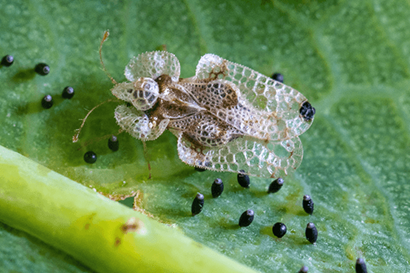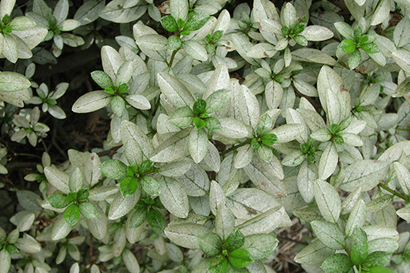Once your trees and shrubs leaf out for the spring and summer, those bright, vibrant green leaves create that lively and lush landscape you enjoy.
But when your leaves seem like they are under attack, showing dark dots along their undersides, your backyard can start to look more like a pointillism painting than the backyard you know and love.
What’s piercing your leaves and sucking the sap from them, leaving that mottled and stippled appearance? They might be lace bugs.
These tiny insects can be pretty annoying, but there is some good news. You can learn how to get rid of lace bugs in your garden and get your yard back to green and growing. Let’s learn more about this pest.
What are Lace Bugs?

Since this pest, like many of those that snack on your plants, is pretty small, you might be wondering, “What does a lace bug look like?”
Lace bugs are about one-eighth of an inch long, so to properly identify them you may want to take out your magnifying glass. Then you’ll see the reason they are called lace bugs: their transparent, patterned wings form a lacy shield over their bodies.
Lace Bug Life Cycle
Lace bugs have three stages that are part of their life cycles.
It starts with lace bug eggs. Female adults insert them in leaves and cover them with dark excrement. These eggs can even last through the winter on evergreen hosts if they are protected by bark or fallen leaves and debris. Once hatched the babies, or nymphs, grow into adults through five stages over a period of a few weeks.
Common Lace Bug Species

Lace bugs are typically host-specific pests. This means that certain lace bug species feed on one type of plant.
Azalea lace bugs infest azaleas in the eastern U.S. in Maryland, New York, Massachusetts, Virginia, Georgia, North Carolina, Alabama, and Florida, as well as western U.S. states of California and Texas.
Hawthorn lace bugs are small and darker in color. They feed on hawthorns, cotoneasters, and Japanese quince in much of the continental U.S.
Rhododendron lace bugs have black bodies and are ⅜ of an inch long with gray wings. They like to attack rhododendron and mountain laurel plants in the eastern U.S.
Sycamore lace bugs are similar in size and color to azalea lace bugs, and they can feed on sycamore, ash, hickory, and mulberry trees. They are found in the eastern U.S. and in eastern Canada, as well as in Texas,
Warning Signs: Lace Bug Damage
Since lace bugs are small, you usually notice lace bug damage first.
Lace bugs like to suck the fluid from leaves, which causes them to look spotted and bleached. This can become pretty apparent by mid to late summer as your whole shrub or section of your tree can look thin and lacy itself. You can also find specks of their dark excrement on the lower sides of plant leaves.
What attracts lace bugs? plant species in sunny spots of your yard usually draw them in.
Trees Susceptible to Lace Bugs
Lace bugs attack a pretty wide range of deciduous trees and shrubs in many regions of the U.S.
The tree and shrub species you’ll find lace bug damage on the most include:
- Azalea
- Rhododendron
- Sycamore
- Ash
- Hickory
- Mulberry
- Hawthorn
- Mountain laurel
- Cotoneaster
- Japanese quince
- Japanese andromeda (Pieris)
- Oak
- Mango
How to Get Rid of Lace Bugs

You can start by removing lace bugs from the leaves with water. But removing adults fully usually takes azalea lace bug systemic control. Spray insecticides with active ingredients like permethrin or bifenthrin are helpful, as well as granular or liquid soil applications containing imidacloprid.
Early lace bug detection in spring and early summer, as well as regularly inspecting susceptible trees and shrubs and taking action only if you properly identify and find them on your plants, is a great way to tackle this pest. Asking a certified arborist for help is always a great option as well.
Azaleas and Japanese andromeda thrive in the shade and are often stressed in the full sun. Lace bugs are much more likely to attack stressed plants growing in the full sun, so planting these species in the shade or planting something that will provide them with shade is a good prevention strategy.





